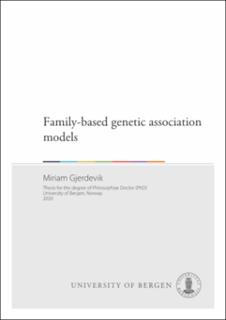| dc.contributor.author | Gjerdevik, Miriam | en_US |
| dc.date.accessioned | 2020-06-04T07:36:41Z | |
| dc.date.available | 2020-06-04T07:36:41Z | |
| dc.date.issued | 2020-06-15 | |
| dc.date.submitted | 2020-05-18T12:17:43.749Z | |
| dc.identifier | container/8a/b5/91/5f/8ab5915f-42ea-4802-a374-0a584ae9d8b8 | |
| dc.identifier.isbn | 9788230843086 | en_US |
| dc.identifier.isbn | 9788230846315 | en_US |
| dc.identifier.uri | https://hdl.handle.net/1956/22452 | |
| dc.description.abstract | The high heritability and recurrence rates observed for several complex diseases justify the search for genetic risk factors. However, despite decades of intense and extensive research, the underlying genetic basis of most complex traits has not been fully deciphered. This unexplained genetic etiology underscores the need to examine etiologic disease mechanisms other than simple genetic effects alone, such as the effect of maternal genes or the effect of parental origin. Additionally, since genome-wide association studies (GWAS) are commonly underpowered due to the large number of single-nucleotide polymorphisms being tested, poorly designed and inadequately powered studies that are unable to capture most of the genetic variants underlying a trait might also contribute to the unexplained genetic etiology. Family-based study designs have been introduced specifically for studies of genetic risk factors. The main study unit is the case-parent triad design, which involves genotyping cases (affected offspring) and both their biological parents. However, a variety of other child-parent configurations and population-based study designs are also amenable to genetic association studies, including (but not limited to) cases in combination with unrelated controls, case-mother dyads, and case-parent triads in combination with unrelated controls or control-parent triads. Large clinical and population-based biobanks and national health registries have created unique opportunities for genetic, epidemiological, and clinical research worldwide. Nonetheless, there is currently a lack of flexible models that accommodate family structure in data. Models that incorporate non-standard genetic effects, such as maternal effects and parent-of-origin effects, are warranted. Moreover, joint models that integrate genetic, environmental, and epigenetic risk factors are needed to elucidate their combined effect on disease. This thesis focuses on models for analyzing GWAS data for binary disease traits as well as methods for maximizing the statistical power of such studies, allowing for a broad range of child-parent configurations in the calculations. Using maximum likelihood estimation in a log-linear model, we developed new methodology to detect parent-of-origin-environment interactions, a possible mechanism contributing to disease susceptibility that has not yet been sufficiently explored. The approach has been implemented in our R package Haplin. In the Haplin framework, we also developed an extensive setup for power and sample size calculations, both through analytic approximations and Monte Carlo simulations, which is essential not only in study planning but also in understanding and interpreting statistical findings. Within the power calculation module, we also implemented a relative efficiency calculator. Relative efficiency measures allow a more informative and general design comparison than straightforward and standard power analyses. We aimed to optimize the study design in genetic association studies given the constraints of available resources, i.e., maximize the statistical power using the least sample collection and genotyping cost. | en_US |
| dc.language.iso | eng | eng |
| dc.publisher | The University of Bergen | eng |
| dc.relation.haspart | Paper I: Gjerdevik M, Haaland ØA, Romanowska J, Lie RT, Jugessur A, Gjessing HK. Parent-of-origin-environment interactions in case-parent triads with or without independent controls. Ann Hum Genet. 2018;82:60-73. The article is available in the main thesis. The article is also available at: <a href="https://doi.org/10.1111/ahg.12224" target="blank">https://doi.org/10.1111/ahg.12224</a> | en_US |
| dc.relation.haspart | Paper II: Gjerdevik M, Jugessur A, Haaland ØA, Romanowska J, Lie RT, Cordell HJ, Gjessing HK. Haplin power analysis: a software module for power and sample size calculations in genetic association analyses of family triads and unrelated controls. BMC Bioinformatics. 2019;20:165. The article is available at: <a href="http://hdl.handle.net/1956/20180" target="blank">http://hdl.handle.net/1956/20180</a> | en_US |
| dc.relation.haspart | Paper III: Gjerdevik M, Gjessing HK, Romanowska J, Haaland ØA, Jugessur A, Czajkowski NO and Lie RT. Design efficiency in genetic association studies. Stat Med. 2020;39(9):1292-1310. The article is available in the main thesis. The article is also available at: <a href="https://doi.org/10.1002/sim.8476" target="blank">https://doi.org/10.1002/sim.8476</a> | en_US |
| dc.rights | In copyright | eng |
| dc.rights.uri | http://rightsstatements.org/page/InC/1.0/ | eng |
| dc.title | Family-based genetic association models | en_US |
| dc.type | Doctoral thesis | |
| dc.date.updated | 2020-05-18T12:17:43.749Z | |
| dc.rights.holder | Copyright the Author. All rights reserved | |
| dc.contributor.orcid | https://orcid.org/0000-0002-2604-2132 | |
| fs.unitcode | 13-26-0 | |
